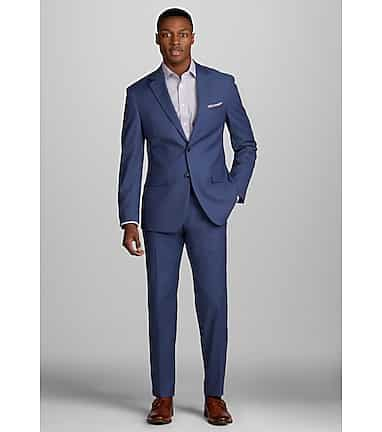Tailored Suits Perth: Elevate Your Design with Custom Suits
Wiki Article
Recognizing the Tailoring Refine: From Material Choice to Last Suitable for the Ideal Closet
The customizing process is a complex interaction of art and scientific research, beginning with the vital choice of material selection and finishing in the exact adjustments of final installations. Each fabric kind brings distinct top qualities that influence not only the aesthetic appeal yet additionally the garment's long life and viability for various events.Relevance of Fabric Selection
Selecting the ideal fabric is crucial in the customizing process, as it straight affects the convenience, longevity, and overall aesthetic of the last garment. The choice of fabric establishes the foundation for the garment's performance, capability, and design. Various textiles have special homes, such as breathability, stretch, and weight, which can substantially affect exactly how the garment drapes and fits the body.
A customized item made from an appropriate fabric not just showcases workmanship yet likewise elevates the wearer's confidence. Recognizing the nuances of fabric choice is extremely important for any type of customizing undertaking. It makes sure that the end product not just meets the visual desires of the customer but additionally lines up with functional needs, thus achieving a harmonious equilibrium between kind and feature in the tailored wardrobe.
Sorts Of Fabrics and Their Usages
Recognizing the numerous kinds of fabrics readily available is vital for making educated decisions during the customizing procedure. Each fabric possesses unique attributes that determine its suitability for certain garments and celebrations.Its versatility allows it to be tailored into whatever from shirts to gowns. Its all-natural flexibility assists garments preserve shape over time.
Silk radiates high-end and is light-weight, making it perfect for eveningwear and delicate shirts; nevertheless, it requires mindful handling due to its fragility. Bed linen, with its textured coating, is a preferred option for cozy climates, giving a crisp and ventilated feeling, however it wrinkles quickly, which may impact the garment's appearance.
Synthetic textiles, such as polyester and nylon, deal sturdiness and resistance to wrinkles, making them appropriate for daily wear and active garments. Comprehending these textile types and their residential or commercial properties permits for better decision-making, making sure that each customized item not just fits well yet likewise lines up with the desired purpose and celebration.
The Tailoring Strategies Described
The art of customizing depends on a variety of strategies that change textile right into well-fitted garments. Central to this process is pattern drafting, where a tailor creates templates based on the customer's dimensions and wanted design. This preliminary action makes certain that the garment will fit the user properly prior to any type of reducing takes place.Once patterns are established, cutting strategies enter into play. Accuracy is critical as mistakes can result in misfitting garments. Tailors commonly make use of different cutting methods, such as single-layer reducing for detailed designs and multiple-layer reducing for effectiveness on common patterns.
Basting is an additional crucial method, enabling dressmakers to temporarily sew material assemble for an initial installation (wedding suits perth). This approach provides the possibility to examine the drape and general silhouette before final sewing
Seaming techniques, consisting of flat-felled seams and French seams, boost the garment's sturdiness and visual charm. Tailors additionally use strategies such as interfacing and extra padding to provide framework and shape to particular areas, like collars and shoulders.
Finally, completing strategies, including hemming and edge finishing, ensure the garment's long life while offering bespoke tailor perth a polished appearance. With each other, these techniques develop the foundation of reliable customizing, causing beautiful, custom-fit garments.

Suitable Modifications and Factors To Consider
After the initial tailoring methods have actually been applied and the garment is constructed, fitting changes become vital to accomplishing the best fit. These changes resolve numerous facets of the garment, ensuring it contours to the wearer's physique and improves overall appearance.
The rise of pants is an additional vital aspect; it should rest conveniently over the hips without causing pain, enabling for simplicity of movement. Hemming sizes for both trousers and skirts must mirror the user's preferred design while respecting proportions.
Additionally, focus should be offered to the rear of the garment, ensuring that there are no unsightly pulls or excess material - tailor perth. Each adjustment ought to be carefully considered, as also minor alterations can significantly influence the overall fit and aesthetic of the tailored item, eventually bring about a wardrobe that radiates confidence and refinement
Preserving Your Tailored Clothes
Correct upkeep of tailored garments is vital to protecting their fit and look in time. To guarantee longevity, routine cleansing is extremely important. Always comply with the treatment tag instructions, which might suggest completely dry cleansing for fragile materials or equipment cleaning for more sturdy products. Prevent regular laundering, as this can use down the fabric and modify the garment's shape.Storage space is equally crucial; use padded hangers for coats and layers to maintain shoulder framework, and shop trousers folded up neatly or hung to avoid creasing. Shield garments from direct sunlight, which can fade colors and damages fibers.
In addition, periodic inspections for minor repair work can prevent larger issues. Check for loosened buttons, fraying seams, or indications of moth damages, addressing these troubles immediately to maintain the garment's honesty.
Lastly, take into consideration seasonal rotation. Putting on tailored pieces in small amounts enables fabrics to recuperate, expanding their lifespan. By implementing these upkeep methods, you can make sure that your customized garments continue to be as beautiful as the day you first wore them, boosting your excellent closet for years to come.
Final Thought
The customizing process, including fabric selection, skilled strategies, and accurate fitting modifications, plays an important duty in creating garments that enhance both comfort and design. Recognizing the relevance of upkeep extends the life of customized garments, solidifying their value in a well-curated closet.Report this wiki page